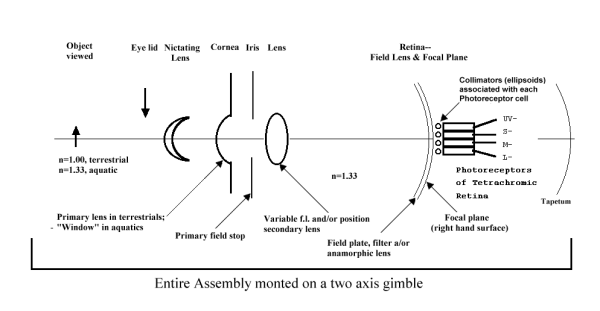
The following figure is presented here at reduced scale (resolution)to accommodate a browser. A larger scale version is available in Chapter 1 in the Download Files area reached from the Site navigation bar.

Generic Optical System of Chordata [from Section 2.3]
Note the generic eye of Chordata accommodates four spectral absorbers. The vast majority of Chordata enjoy tetrachromatic vision. It is the large chordates, primarily those living on land and including human, that are limited to trichromatic vision by the spectral absorption inherent in the cornea and lens of the eye. The cornea and lens are much thicker in these animals because of the difference in index of refraction between air and water.
A nictating lens is shown since this feature is used in a wide variety of animals living at, and frequently crossing, the air water interface.
Note also the significant curvature of the retina. This curvature is a compromise allowing the eye to obtain a very wide angle of vision within a packaging constraint compatible with a nearly as wide angle of eye rotation.
Because of the very sophisticated optics used in the eye, as suggested by the variable focal length required to focus an image on the inside of a spherical surface, Gaussian Optics are not adequate to describe the performance of the eye for research purposes.
The neural tissue found in the optical path between the optics and the photoreceptors is frequently shaped so as to act as an additional lens.
The figure stresses that the eye is mounted on a two axis gimbal, although it is technically a three axis gimbal to allow correction for the non-orthogonal mounting of the muscles controlling the pointing of the eye. Two of the six muscles of the eye are used primarily to provide correction of this error in "roll."
The above features are discussed in detail in Chapter 2.